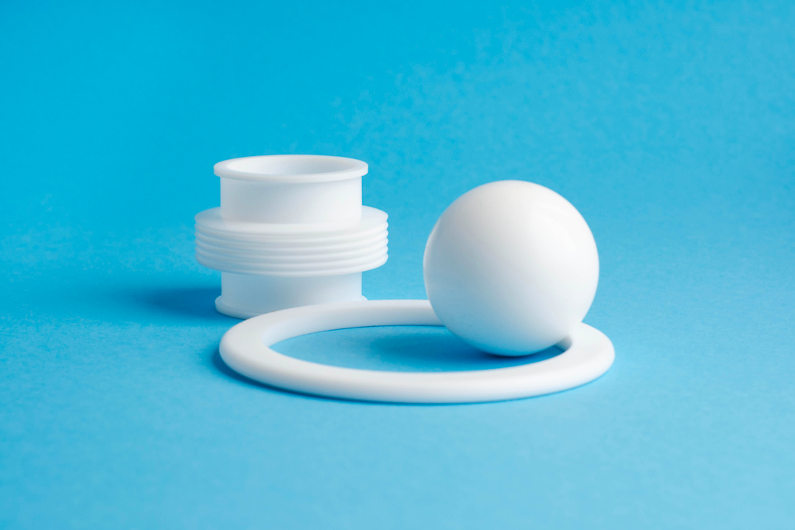Telfon has become a very common household name due to its wide variety of uses across many different types of materials. Teflon is used from anything from non-stick pans to lubricants to military grade equipment. Its versatility makes it a very common component in the manufacturing industry, allowing it to be used for many different types of applications.
To better understand how teflon is used in different environments, we first have to look at the many different types of teflons used in manufacturing to achieve the great qualities that it is known for.

Today, we are going to look at the 6 most common types of teflon coating and compare how they differ from each other.
Teflon PTFE
Polytetrafluoroethylene (PTFE) is best known for its brand name of Teflon, which is owned by the company Chemours. PTFE is a high-molecular-weight fluorocarbon solid that contains carbon and fluorine. It has hydrophobic characteristics meaning water does not wet PTFE.
PTFE is commonly found in pans and cookware that have non-stick coatings. Due to its non-reactive properties, it can be used in containers and pipes where corrosive or reactive chemicals are used. PTFE can also be used as a lubricant to help reduce the wear, friction, and energy consumption of common machines. In the medical field, PTFE is used quite frequently in surgeries as a grafting material. It is the most resistant to heat out of the various teflon materials, with temperature ratings up to 500 degrees Fahrenheit. This form of teflon is only available in liquid form and is water based, which can be a downside for many manufacturers.
Teflon FEP
Teflon FEP is going to be another type of teflon that you can use. FEP stands for fluorinated ethylene propylene copolymer and is one of the teflon materials that is going to be a non-porous film. When baking this type of teflon, FEP melts and flows to form around the object that you are coating. This is a great options for really getting around some of the more intricate objects that you need coated in teflon FEP.
One of the biggest advantages to FEP is that it is very resistant to most of the commonly used chemicals. This is a huge plus as it widens the range of uses for the object that is being coated. This allows for objects that are normally not-resistant to these chemicals to be coated and become resistant thanks the the protective layer of FEP. It also exhibits a highly non-stick characteristic which can be used for a variety of uses as well. You will find teflon FEP in both a water-base liquid, similar to PTFE, and a powder, both of which are commonly used in the manufacturing industry.
Teflon PFA
Moving on to the next type of teflon, PFA, you will notice that it shares many of the same qualities as FEP. They are both available as a powder and water based liquid and can be used for items that need to be chemical resistant. The main differences and advantages of PFA is going to be its resistance to heat and it’s toughness. When comparing PFA to PTFE and FEP, you will see that PFA is going to be much tougher than its latter coatings. It is going to resist heat much better than FEP, ranging in the 500+ degree farenheit area, much similar to PTFE. PFA is going to stand for perfluoroalkoxy and is a great coating for items that are going to see a lot of abuse and high temperatures.
Tefzel ETFE
Telfon is known primarily for its strength, and one of the toughest fluoropolymers that they offer is going to be ETFE, or Ethylene tetrafluoroethylene. Teflon sells this ETFE under the name Tefzel, and it was originally designed to resist corrosion and a wide temperature range. One of the most important things to realize about Tefzel ETFE is that it is not completely fluorinated and is only available in a powder form. This is something to keep into consideration when debating whether to use ETFE in your manufacturing processes. You will see this type of teflon used in pneumatic panels that cover stadiums and outdoor facilities.
Teflon One Coat
If your manufacturing process requires a Teflon coating that is solvent based, not water based like many of the other coatings that we have discussed in this article, Teflon One Coat can be your solution. Made to resists abrasions and to be extremely tough, One Coat goes through an extensive blending process to help achieve these sought after qualities. A huge advantage to using One Coat is that unlike the other coatings that require a rough surface to adhere to, One Coat can be laid onto a smooth metal surface without having to make any type of modifications. This is going to be a great solution for those looking for a tough coating for their smooth metal materials. It is also FDA approved for food contact regulations and has an excellent thermal stability and non stick qualities which are great for cooking material applications.
Teflon Dry Lubricant
Last but not least is the teflon dry lubricant, a solvent based lubricant that can be used to coat materials that will see a lot of pressure or high velocities. You are going to find this used in a variety of different aerosol spray cans such as WD-40 and DuPont related products. This lubricant helps to reduce friction and wear on metals that rub against each other and can even be used to help loosen stuck bolts and nuts. It is going to be one of the most commonly used Teflon products by consumers in its raw form.
Conclusion
So there you have it, 6 of the most common type of teflon coating explained and compared to give you a quick understanding of each type. We hope that this has given you some insight on how each type is made and used to accurately identify the type of teflon surface you may need or have used.



